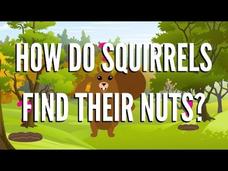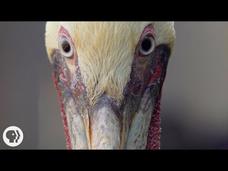Be Smart
Why Is Blue so Rare in Nature?
Why so blue? As it turns out, very few things in nature only reflect blue light! A short video from a comprehensive science playlist highlights the beautiful blues of butterflies, birds, and human eyes. The narrator shows how adaptations...
Curated OER
For the Birds
Second graders explore biology by creating birdhouses. In this bird identification lesson, 2nd graders discuss the different types of birds that live in their environment and what characteristics each type of bird has. Students create a...
Curated OER
Name That Bird
Students view web sites about Birding. They explore how to identify species using a bird's silhouette, posture, size, flight patterns and habitat. They practice birdwatching and notetaking in the outdoors.
Curated OER
Hooray for Birds!
Students explore the theme of birds through both indoor and outdoor activities. In this bird studies lesson, students go bird watching and compare the types of birds seen. They also study bird calls, bird environments, and bird pictures...
Curated OER
For The Birds
Student make bird feeders and describe feeding behaviors. In this bird feeder lesson plan, students construct simple bird feeders. They then put them outside and observe the feeding behaviors of birds. Then they graph the number of birds...
Curated OER
For The Birds
Students observe birds building their nests. In this habitat instructional activity, students develop a Best Building Supply Bag and record how the birds build their nests. Students keep a Field Journal.
PBS
Real-Life Math | Zoo Keeper, Birds
Birds of a feather flock together, so it's easy to estimate their number. Pupils watch an installment of a larger Real-Life Math series in which a zookeeper explains how she uses math to estimate the number of birds. They then try out...
PBS
Dinosaur Train: Drawing Birds
Kindergarten and first graders watch a video about the characteristics of birds.They then go outside, observe local birds, and discuss the characteristics. Next, they choose one to draw, and are instructed to include all of its...
Curated OER
Help the Duck Find Her Babies
Students are introduced to a basic characteristic and need of living things-the ability and need to reproduce. They investigate how birds (and people) attract mates. Students discover how to build a nest. They discuss the needs and...
Curated OER
Bird Airport Control
Students visit a local wetland and record observations of waterfowl on downloadable worksheets. They compile class data and list similarities and differences among species of birds observed.
Curated OER
Bird Watching
Students explore the implications of the avian flu. In this personal health lesson, students listen to a lecture about the avian flu, its history, and how it spreads.
Rockin' English Lessons
What is It? Animals Song
What is it? It's a song about animals! Listen and watch while the singer reads and displays the lyrics and hand-drawn animations for a bird, dog, cow, and elephant.
Be Smart
Did Dinosaurs Really Go Extinct?
Most meat-eating dinosaurs had bones filled with air, just like today's birds. Scholars explore the idea that humans still live with dinosaurs, aka birds in a video that explains how researchers determined that modern birds descended...
Be Smart
How Do Squirrels Find Their Nuts?
Viewers of this short video learn how squirrels and birds not only find their stored nuts in winter but also distract would-be thieves. Viewers see that animals have the ability to take action today (burying nuts) to fulfill their future...
Deep Look
How Do Pelicans Survive Their Death-Defying Dives?
Get ready to take the plunge! Science scholars go fishing with a brown pelican and see how it can withstand the impact of the water from a height of 40 feet. The narrator shows the birds in action and describes the physical adaptations...
Alabama Learning Exchange
Ice Fishing is for the Birds
Approach addition with young mathematicians in an engaging way through this penguin-inspired activity. In small groups, scholars think about times they have used addition in their real lives (there are some suggestions given), then watch...
Curated OER
Bird Eggs
Students perform an experiment with different types of bird eggs to determine what factors make them strong and able to stay on a cliff without rolling off.
Curated OER
Bird Binoculars
Pupils create binoculars using empty toilet paper rolls, yarn, and glue in this Art lesson for the early-elementary classroom. This Art project could be combined with a Science unit on Birds or nature, and could include a short field...
Curated OER
Backyard Bird Watch
Learners use the Internet, digital cameras, video cameras and other computer technology to observe and record information on local birds that visit their bird feeders. They consider factors such as weather and seed consumption.
SciShow
IDTIMWYTIM: Bird or Dinosaur?
When was the last time you ate a dinosaur? Viewers might just be surprised when they learn the answer from a video that explains what is and what is not a dinosaur. Classification systems and definitions are picky things, and as the...
The Brain Scoop
How Bird Vomit Helps Us Understand History
They didn't just WING this video; it's a real HOOT! An intriguing video in the Brain Scoop Fossils & Geology series explains what owl pellets are and why scientists study them. Then, it covers the extension of how scientists use them...
K20 LEARN
The Sirens: Is It a Bird or Is It a Fish?
Fish, fowl, foul fish, or foul fowl? Just what is a siren? Young scholars listen to a video clip and draw what they imagine when they hear the word "siren." After watching several videos depicting sirens, class members read "The Sirens'...
Curated OER
Watch the Birdie
Students complete a six-week unit on North American birds. They conduct research, develop fact sheets, create labeled bird drawings, write a dictionary of bird vocabulary words, create a Concentration game, and observe birds in their...
Curated OER
Develop a Bird Feeder Watch List
Students explore biology by identifying animals on their school ground. For this bird species lesson, students create and utilize a simple bird feeder to attract birds near their classroom at which point they observe the color, size and...

























